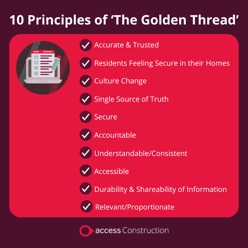What Is ‘The Golden Thread’ In Construction?
With a focus on creating a safer built environment, the golden thread was introduced as part of the Building Safety Act and outlines how accountable persons must now priortise their information management processes. We break down what this means for your company and how to manage your ‘golden thread’ information.
Contents
- What Is ‘The Golden Thread’ In Construction?
- What Is The Building Safety Act?
- What Are The Principles of the Golden Thread in Construction?
- What Information Do Construction Contractors Need For The Golden Thread?
- How Do You Manage Golden Thread Information?
- Why Do Construction Contractors Need To Manage Golden Thread Information?
What Is The Golden Thread in Construction?
The golden thread is a new set of guidance on how to store, manage and share building information within the construction industry.
Forming part of the Building Safety Act, the ‘golden thread’ of information refers to a new set of legislation and guidance on how to store, manage and share information on a building. The Building Safety Regulator (formerly BRAC) defines this further in their golden thread report, explaining:
‘The golden thread is both the information that allows you to understand a building and the steps needed to keep both the building and people safe, now and in the future’.
Within this article, we will break down what this means for you and the wider construction industry, defining the 10 key principles of the golden thread and how you can stay compliant under this new legislation.

What Is The Building Safety Act?
The Building Safety Act is a ground-breaking set of legislation in the United Kingdom aimed at addressing and improving building safety standards.
Introduced in response to the tragic Grenfell Tower disaster in 2017, The Building Safety Act made sweeping reforms to give residents and homeowners more rights, powers, and protections – enabling buildings across the country to become safer.
Primarily, the act introduces new measures to improve the construction, design, and management of these high-rise structures, particularly in regards to fire safety. The new legislation includes major changes to the legal requirements for higher-risk buildings, increased responsibilities for building owners, and changes to fire safety legislation.
Following the Grenfell tragedy, the government appointed Dame Judith Hackitt to conduct a comprehensive review of existing building regulations and fire safety.
In her report, Dame Judith highlighted the need for a ‘golden thread’.
She described the golden thread as a tool to manage buildings as holistic systems, which would allow parties to use information to safely and effectively design, construct and operate their building.
Her investigation had found that there was a pattern of key building information being ineffectively managed and misplaced, alongside a lack of accountability for documenting changes such as change of ownership.
Ultimately, the government committed to implementing Dame Judith’s recommendations, introducing new measures and legislation under the Building Safety Act which was granted royal assent on April 28, 2022.
What Are The Principles of the Golden Thread in Construction?
These were first established by the BRAC, which has now been replaced by the Building Safety Regulator. Designed to underpin the golden thread’s definition, the golden thread’s principles provide more detail on what’s required to manage the golden thread.
Following these 10 principles will help duty-holders or accountable persons to meet the new government expectations.
Those involved in the duty of care of a building, including relevant parties such as contractors, must be able to use the golden thread to maintain and manage building safety. Additionally, the regulator should be equipped to leverage this information in their assessments, evaluating compliance with building regulations, the overall safety of the building, and the operator's safety case report, complete with supporting evidence.
Quite simply, this information should serve as a basis for holding individuals accountable and keeping information up-to-date. Designed to help ensure this, the 10 key principles outline that the golden should be:
1. ‘Accurate And Trusted’.
The golden thread must be accurate and trusted so that relevant people can reliably use it. The information produced must be accurate, structured, and verified.
2. ‘Residents Feeling Secure In Their Homes’.
Information will be provided to residents, to enable them to feel safe in their homes. A well-maintained golden thread will support accountable persons in providing residents assurances that their building is being managed safely.
3. ‘Culture Change’.
The golden thread should be considered an enabler for better and more collaborative working. It will require increased competence and capability, different working practices, updated processes and a focus on information management and control.
4. ‘Single Source Of Truth’.
The golden thread will bring all information together into one single source of truth. This will involve tracking all changes and the reason for these changes.
5. ‘Secure’.
The information within the golden thread must be secure to protect personal information and control access, complying with GDPR legislation at all stages.
6. ‘Accountable’.
The golden thread will record all changes, as well as who made them. This will foster improved accountability, ensuring there is a responsibility for all parties involved from the client to the accountable person.
7. ‘Understandable/Consistent’.
The information in the golden thread must be clear, understandable and focused on the needs of the user. It should be presented in a way that can be understood, and used by, users.
8. ‘Simple To Access (Accessible)’.
All information should be readily available to those who need it. This means that the information needs to be stored in a structured way so people can easily find, update and extract the right information.
9. ‘Longevity/Durability And Shareability Of Information’.
The golden thread must be maintained throughout the entire life cycle of a building. Therefore the information should always be relevant, and shareable across different parties.
10. ‘Relevant/Proportionate’.
The golden thread does not require every bit of historical information to be tracked and kept. Instead it should always include the most relevant information required to accurately maintain building safety.
For a more in-depth look at these explanations, you can review the full guidance provided by BRAC here.

Manage Your Golden Thread Information with Construction Management Software from Access Construction
Access ConQuest, our construction estimating software, and Access Coins ERP are both powerful tools to help you securely manage your golden thread.
What Information Do Construction Contractors Need For The Golden Thread?
This question is a little harder to answer, as it depends entirely on your building and its current stage of life or project milestone. However, there are key aspects to keep in mind.
The golden thread does not outline or define specific information that must be kept. Instead it highlights the need to make the storing and maintaining of accurate and relevant building information a priority.
Firstly, all information stored must be proportionate and essential for the ongoing development or maintenance of a building’s fire safety. Depending on the building’s stage of development, the information you store and share as part of the golden thread will need to be altered.
During pre-construction and the build stages, you must prioritise information that pertains to the building’s intended safety measures and how they comply with current regulations.
This could include information relevant to planning applications such as:
- Site layout
- Water supplies for fire management
- Local access to fire services
The Building Safety Regulator (BSR) will now become the building control authority for high-rise buildings. Therefore ensuring you maintain a high quality golden thread of information is essential, as it forms part of the design application which must now be submitted to the BSR before any work can continue on a high-rise building.
“The golden thread will hold the information that those responsible for the building require to:
- show that the building was compliant with applicable building regulations during its construction and provide evidence of meeting the requirements of the new building control route throughout the design and construction and refurbishment of a building
- identify, understand, manage and mitigate building safety risks in order to prevent or reduce the severity of the consequences of fire spread or structural collapse throughout the life cycle of a building”
From Building Regulations Advisory Committee: golden thread report
How Do You Manage Golden Thread Information?
At a glance, all your building’s golden thread information must be:
- kept digitally
- kept securely
- a building's single source of truth
- available to people who need the information to do a job
- available when the person needs the information
- presented in a way that any relevant person can use
The golden thread is more than just the information you store and manage on your building. It also refers to the information management process that you and your teams follow to control this information.
There are already numerous standards within the UK that set out ideal approaches to digital information management. Existing frameworks such as the UK BIM Framework are still available and appropriate for the implementation of the golden thread.
Set out in the Construction Playbook, the government already requires that any publicly procured buildings adhere to the UK BIM Framework. So referring to these existing frameworks is a great way to ensure you are following proven industry standards.
For larger projects or building portfolios, it may become to difficult to manage all this information manually. This had lead to most leading construction companies to adapt their internal processes, through the use of software such as ERP (Enterprise Resource Planning).
This innovative software helps construction companies manage their business operations by creating an integrated system which connects teams, projects and information in one place.
ERP also enables construction businesses to more effectively manage their golden thread of information by automating the data collecting, sharing and updating processes. However, each ERP will differ greatly in their features and suitability to your business, so it’s always important to carry out independent research to find the right solution for you.

Why Do Construction Contractors Need To Manage Golden Thread Information?
The golden thread is a now a key part of the new and more stringent regime for building safety in higher-risk buildings.
The Building Safety Act, which carries the golden thread policies within it, has now been granted royal assent and is now fully enforced.
The golden thread policy, alongside the Building Safety Act will create a clearer and more proportionate framework for the design, construction, and management of safer, high-quality homes in the years to come.
Now only will it provide unprecedented protections to residents living within high-risk (high-rise) buildings, but it will also help protect construction companies and contractors throughout the UK. By putting more ownership and responsibility on the construction sector, you can help prevent disasters such as Grenfell.
Access Coins ERP Provides A Single Source of Truth For Golden Thread Information
Built for the construction sector, Access Coins ERP is an end-to-end management solution providing construction contractors visibility and control over every part of the construction lifecycle.
Fully integrated and cloud-hosted, Access Coins ERP helps you take control of your information management process, pulling all your building’s information together into one single source of truth.
Developed to support the every-changing legislation of the construction industry, Access Coins ERP helps you manage risk, save time and remain compliant through a suite of modules which can be accessed by any of your team at any time.


 AU & NZ
AU & NZ
 SG
SG
 MY
MY
 US
US
 IE
IE




